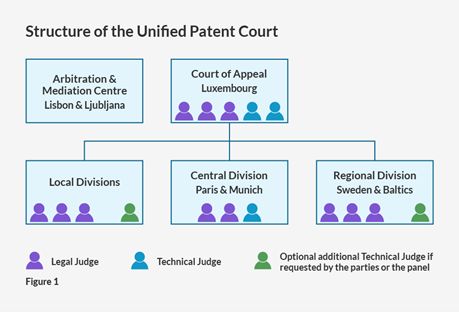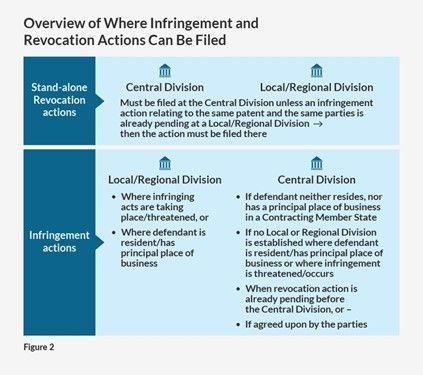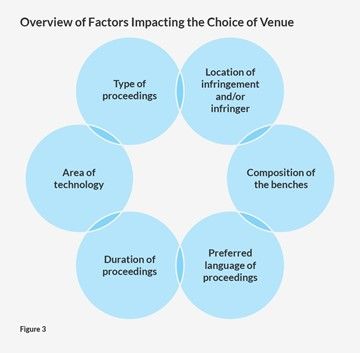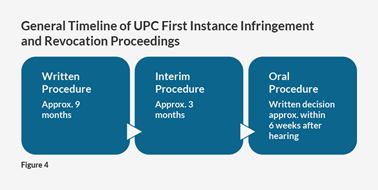As widely reported, the Unified Patent Court (UPC), the first transnational patent court in Europe, will open its doors and receive cases starting June 1, 2023. The so-called "sunrise period" for the UPC (triggered by the recent deposit of Germany's ratification of the UPC agreement) starts on March 1, 2023. This practice note discusses the structure of the UPC and the factors to consider for venue selection within the UPC system.
See European Patent Application Fundamentals for a discussion of how to obtain European patents, including the new European patent with unitary effect (Unitary Patent) over which the UPC has jurisdiction. For a quick reference on European patent applications, see European Patent Fundamentals Checklist.
Background
The establishment of the UPC is one of the biggest changes in European patent law in decades. It creates a common court for patent litigation with rulings that can have unitary effect in up to 24 member states of the European Union (EU) once those EU member states that have signed the Agreement on a Unified Patent Court (UPCA) have also ratified it (the Contracting Member States). When it is operational, the UPC will have jurisdiction over patent disputes in a territory with a significantly large population and trillions of Euros of gross national product.
For the UPC to start operating, at least 13 of the signatory member states, including France and Germany, must ratify the UPCA and deposit their instruments of ratification. As of February 17, 2023, 17 of the 24 signatory member states, including France and Germany, have done so. That means at least 17 EU member states will be participating in the new system when it starts to receive cases on June 1. Additional signatory member states are expected to ratify the UPCA later. Since membership of the UPCA is open to member states of the EU only, following its departure from the EU, the United Kingdom will not participate in the UPC.
Advantages of the UPC
The UPC was designed to provide litigants with certain advantages, including the following:
- A single decision with unitary effect. Litigants will obtain a single decision with unitary effect in all Contracting Member States where the European patent- in-suit is in force.
- One judgment for enforcement. Procedurally, only one judgment will need to be enforced.
- Lower litigation costs. The cost of a single proceeding before the UPC will likely be lower than that of multiple national proceedings in various Contracting Member States where the European patent is in force.
- Speed. UPC seeks to solve proceedings relatively quickly. These advantages make the UPC very attractive for both patent owners and accused infringers, particularly compared to the alternative of engaging in multiple national proceedings.
Disadvantages of the UPC
While the UPC system has its advantages, there are also some perceived downsides and potential risks, including the following:
- Central revocation. A UPC decision revoking a European patent will take effect in each Contracting Member State where the patent is in force. A single UPC revocation proceeding is less costly than separate proceedings to revoke the patent in each member state, making it an attractive option for accused infringers. However, central revocation poses a significant risk to owners of European patents or supplementary protection certificates (SPCs) that extend patent terms.
- Judgment enforcement uncertainties. The enforcement of one judgment in several countries with different legal systems may present challenges and uncertainties, at least until the concept has been sufficiently road-tested.
- No established case law. Currently, no established UPC case law exists.
- Judges from different countries. The UPC's use of mixed benches with judges from different jurisdictions may lead to differences of opinion and less predictable outcomes.
In addition, the UPC is more complex than national court systems. Litigants need to understand how the UPC is structured, how the panels are composed, and how to make the chances of success more predictable by choosing the right venue under the UPC system.
UPC Jurisdiction
Under Art. 32 UPCA, the UPC shall have "exclusive competence" (i.e., exclusive subject matter jurisdiction) for certain disputes relating to:
- European patents (i.e., so-called classic European patents) and related SPCs, as long as they have not been opted out of the UPC's jurisdiction (see European Patent Application Fundamentals — The UPC Transitional Opt- Out Period) –and–
- Unitary patents (a new type of European patent)
- The following actions can be brought in the UPC (Art. 32 UPCA):
- Infringement actions and counterclaims for revocation
- Revocation actions and counterclaims for infringement
- Provisional and protective measure requests (e.g., requests for preliminary injunctions or seizure of evidence)
- Actions for declarations of noninfringement
- Actions for damages or compensation derived from the provisional protection conferred by a published European patent application
- Actions relating to the use of the invention before the patent grant or a right based on prior use of the invention –and–
- Certain other actions (e.g., for compensation for licenses under Art. 8 of EU Regulation (EU) No 1257/2012, which allows Unitary Patent owners to file a statement with the European Patent Office indicating that they are prepared to license the invention for appropriate compensation)
During a seven-year transitional period after entry into force of the UPCA (which may be extended up to an additional seven years), infringement and revocation actions relating to classic European patents or SPCs may, however, still be brought before national courts (see Art. 83 UPCA; so-called "alternative jurisdiction").
Note that the proprietor of a European patent or a related SPC may opt out the patent or the SPC from the UPC's jurisdiction during the transitional period unless an action has already been brought before the UPC (see Art. 83(3) UPCA).
Such opt-out can also be withdrawn if the European patent or SPC proprietor wants to make use of the UPC system at a later stage unless an action has already been brought before a national court (Art. 83(4) UPCA).
The territorial scope of the UPC's decisions is the territory of the Contracting Member States in which the European patent is in effect (Art. 34 UPCA). However, under the Brussels Regulation (Regulation (EU) No 1215/2012 of 12 December 2012 amended by Regulation (EU) No 542/2014 of 15 May 2014), under certain conditions, the UPC also has a so-called "long-arm jurisdiction." For example, that means the court may have the power to award damages arising from an infringement of a European patent not only in the EU but also "arising outside the Union from such an infringement" (Art. 71(b)(3) Brussels Regulation).
UPC Court Structure
The UPC comprises a Court of First Instance and a Court of Appeal (Art. 6 UPCA) with various locations in the Contracting Member States. UPC panels are composed of three to five judges from different member states (Art. 8(1) UPCA), one of them being the chair. The structure of the UPC is summarized in Figure 1 below.

Figure 1: The structure of the UPC
Courts of First Instance
The Courts of First Instance consist of several Local and Regional Divisions (Art. 7(1) UPCA) and a Central Division (Art. 7(2) UPCA), which shall have three seats. The panels of the Courts of First Instance, in general, comprise three judges. The panel of the Central Division consists of two legally qualified judges and one technically qualified judge, whereas the Local and Regional Divisions have three legally qualified judges and may optionally add a technically qualified judge. Legally qualified judges have a qualification in law. Technically qualified judges must have a university degree, "proven expertise in a field of technology," and "proven knowledge of civil law and procedure relevant in patent litigation" (Art. 15 UPCA). For a list of appointed judges, see here.
Local and Regional Divisions
Local and Regional Divisions are established as follows:
- Local divisions. The Local Divisions each consist of three legally qualified judges, two of whom are nationals of a Contracting Member State other than the member state hosting the division. However, if 50 or more patent cases per calendar year on average have been commenced at the Local Division three years before the entry into force of the UPCA, then two of the three judges are nationals of the member hosting the Local Division (Art. 8(2)(3) UPCA).
- Regional divisions. The panels of the Regional Divisions also comprise three legally qualified judges, two of whom are nationals of the Contracting Member State hosting the division and one of whom is a national of another Contracting Member State (Art. 8(4) UPCA).
Under certain circumstances, a technically qualified judge (with experience in the field of technology for the patent concerned) may be added to the panels of the Local and Regional Divisions (e.g., on request of the parties or where the court considers this appropriate). See Art. 8(5) UPCA.
On July 8, 2022, the UPC announced the Local and Regional Division locations. These include the following:
- Austria (Vienna)
- Belgium (Brussels)
- Demark (Copenhagen)
- Finland (Helsinki)
- France (Paris)
- Germany (Düsseldorf, Hamburg, Mannheim, Munich)
- Italy (Milan)
- Netherlands (The Hague)
- Slovenia (Ljubljana)
- Portugal (Lisbon) –and–
- A regional Nordic-Baltic Division, which will be mainly seated in Stockholm, Sweden
Central Division
The panels of the Central Division comprise three judges. Two are legally qualified judges who are nationals of different Contracting Member States. The third judge is a technically qualified judge with qualifications and experience in the relevant technology (Art. 8(6) UPCA).
However, in actions concerning certain decisions of the European Patent Office, the Central Division panel comprises three legally qualified judges who are nationals of different Contracting Member States (Article Art. 8(6) UPCA).
Originally, under Art. 7(2) UPCA, the Central Division was to have three locations in Paris, Munich, and London. Following the UK's departure from the EU, the third location is expected to be replaced, but its new location has not been finally confirmed, nor has its timing been announced. In the interim, it seems likely that the Munich and Paris locations will be assigned the cases that would have been decided in London and split them in some fashion until a new third location is determined.
Cases in the Central Division are allocated as follows according to their technical subject matter:
- Munich. Mechanical engineering, lighting, heating, weapons, and blasting.
- Paris. Performing operations, transporting, textiles, paper, fixed constructions, physics, and electricity. –and–
- Third location (formerly London). Human necessities, chemistry (i.e., Life Sciences), and metallurgy.
Court of Appeal
The Court of Appeal, which is seated in Luxembourg, sits in a multinational composition of five judges, comprising three legally qualified judges from different Contracting Member States and two technically qualified judges with qualifications and experience in the field of technology concerned (Art. 9(1) UPCA). In actions concerning certain decisions of the European Patent Office, the panel comprises three legally qualified judges who are nationals of different Contracting Member States. The individuals appointed to the Court of Appeal can be found here.
Referrals to the European Court of Justice
The Court of Justice of the European Union (commonly known as the European Court of Justice or CJEU) is a court that rules on issues of EU law. It interprets EU law to ensure it is applied in the same way in all EU countries.
Since the UPC is part of the EU legal system, it can refer questions to the CJEU to ensure the correct application and uniform interpretation of EU law under Article 267 of the Treaty on the Functioning of the European Union (TFEU) (cf. Art. 21 UPCA).
Where to File an Action in the UPC?
Art. 33 of the UPCA controls where actions can be filed in the UPC. Below we take a closer look at the venue options for the actions of main interest, namely patent infringement and revocation actions.
Venue for Infringement Actions
An infringement action can generally be filed in a Local or Regional Division or the Central Division. It can be directed at multiple defendants if they have a commercial relationship with each other and if the action relates to the same alleged infringement (Art. 33(1)(b) UPCA).
In particular, infringement actions can be brought before the Local or Regional Division of the Contracting Member State where the actual or threatened infringement has occurred or may occur (Art. 33(1)(a) UPCA). Alternatively, an infringement action can also be filed where the defendant (or in the case of multiple defendants, where one of them) is domiciled (Art. 33(1)(b) UPCA).
If the defendant has no residence, principal place of business, or any place of business in the Contracting Member States, the infringement action can be brought before the Local or Regional Division where the infringement has occurred, or the threatened infringement may occur (Art. 33(1)(b) UPCA).
An infringement action can be brought before the Central Division in any of the following circumstances:
- The defendant is domiciled outside the territory of the Contracting Member States (Art. 33(1)(b) UPCA).
- The Contracting Member State where the infringement has occurred or is threatened does not host a Local Division or participate in a Regional Division (Art. 33(1) UPCA).
- A revocation action between the same parties relating to the same patent is already pending before the Central Division (Art. 33(5) UPCA). –or–
- The parties have agreed to bring the action before the Central Division (Art. 33(7) UPCA).
If an infringement action is pending before a Regional Division, and the infringement has occurred in the territories of three or more Regional Divisions, the defendant may request that the case be referred to the Central Division (Art. 33(2) UPCA).
Even if a revocation action is already pending before the Central Division, an infringement action between the same parties relating to the same patent may still be brought before any Local or Regional Division where the infringement occurred or where the defendant is seated (Art. 33(5) UPCA).
Venue for Revocation Actions
Revocation actions shall be filed with the Central Division (Art. 33(4) UPCA). However, if an infringement action between the same parties relating to the same patent has already been filed with a Local or Regional Division, the revocation action must be brought before the same Local or Regional Division (Art. 33(4) UPCA).
The venue rules for infringement and revocation actions are summarized in the chart below.

Figure 2: Overview of where infringement and revocation actions can be filed
Bifurcation
Germany is one of the preferred venues for patent litigation in Europe. Germany has a bifurcated patent litigation system. That means that patent infringement and validity issues are decided in separate proceedings in different forums. Even under the recently amended German Patent Act—where proportionality may factor in—injunctive relief is generally granted if infringement is established and there is no sufficient likelihood of the patent being revoked. Often an infringement ruling issues before the validity decision, leading to a scenario where an injunction against infringement may be granted before patent validity has been finally adjudicated (the so-called "injunction gap").
That is different at the UPC, which has the ability to have both infringement and validity decided within the same proceeding. However, bifurcation can also occur in certain scenarios within the UPC (Art. 33(3) UPCA). For example, if the defendant in the infringement proceeding brings a counterclaim for revocation, the relevant Local or Regional Division has discretion to take the following courses of action:
- Proceed with both the infringement action and the counterclaim for revocation (including adding a technically qualified judge with qualifications and experience in the field of technology concerned). –or–
- Refer the counterclaim for revocation to the Central Division and either stay or proceed with the infringement proceedings (i.e., bifurcate validity from infringement). – or–
- Refer the entire case to the Central Division if the parties consent.
It remains to be seen whether and how often the UPC judges will use the bifurcation option.
Considerations When Choosing a Venue within the UPC
To enforce or attack patents successfully before the UPC when more than one venue is available, litigants need to be careful about their venue strategy. As explained above, a number of factors can influence venue selection, such as the kind of proceedings, the location where the infringement took place, and where the defendant is domiciled. However, other factors may also play a crucial role, such as the composition of the benches, the prior experience and ruling practices of the judges, the area of technology of the asserted patent, and the preferred language for the proceedings. In addition, potential differences between the available Local and Regional Divisions regarding speed or proficiency in handling proceedings should be considered.
Important factors to consider in choosing the venue for a UPC action are summarized in the chart below.

Figure 3: Overview of factors impacting the choice of venue
Composition of the Benches
The ruling practices of the national courts of EU member states in patent cases have only been aligned to a limited extent. Referrals of questions of law to the CJEU from national courts have provided some guidance on a few specific legal issues, but the ruling practices of the different EU national systems as such have not been fully harmonized.
As a result, in the UPC, differing opinions may arise due to UPC judges bringing in their own specific backgrounds and experience gained under different national systems in the EU. This will likely influence the handling of cases and have an effect on the development of UPC case law. Within the first few years of the UPC, a so-called couleur locale may hence develop (i.e., the First Instance Local and Regional Divisions may create their own ruling practices).
Accordingly, it seems likely, that—in particular, when the new system commences—litigants might be inclined to choose those venues where they are already familiar with the judges. For example, if two out of three judges are nationals from the same jurisdiction with well-established rulings, this might make litigants feel more comfortable about the predictability of the outcome of the case.
Over time, a greater degree of harmonization of the UPC system should take place, with appeals helping to shape and harmonize the case law. Litigants should, therefore, carefully monitor the development of the case law for the UPC and factor that into their venue choice in the future.
Area of Technology
The technical experience of the benches is also an important factor in choosing a venue. This factor is obvious for the Central Division, which will deal—as outlined above—with designated technical fields in each location, and their panels will always comprise a technically qualified judge. If venue selection is possible, a claimant might thus choose the Central Division to ensure that a technical judge will be involved and that the case is handled by a Division designated to deal with the area of technology for the asserted patent(s).
Furthermore, certain judges of the Local and Regional Divisions will likely have developed specific expertise for certain areas of technology based on their previous national experiences. So, prior technical expertise gained by judges in national proceedings will also be a factor that UPC litigants may consider when choosing a UPC venue.
Language of the Proceedings
In First Instance proceedings at the Central Division, the language of the proceedings is the language in which the patent-in-suit was granted (Art. 49(6) UPCA).
The language of the proceedings before any Local or Regional Division may be the following:
- The official EU language of the Contracting Member States hosting the relevant division (e.g., German at the UPC Local Divisions in Düsseldorf, Hamburg, Mannheim, and Munich), or the official language(s) designated by the Contracting Member States sharing a Regional Division
- (Art. 49(1) UPCA)
- One or more official languages of the European Patent Office designated by the Contracting Member States asthe language(s) of proceedings of their Local or Regional Divisions (Art. 49(2) UPCA) –or–
- The language of the patent-in-suit if the parties agree and the panel approves (see Art. 49(3) and (4) UPCA)
The language of the proceedings before the Court of Appeal is the language of the proceedings before the Court of First Instance (Art. 50(1) UPCA). The parties may also agree to use the language in which the patent was granted (Art. 50(2) UPCA). Only in exceptional cases may the Court of Appeal, with the parties' consent, designate another official language of a Contracting Member State as the language of the appeal proceedings (Art. 50(3) UPCA).
Arrangements for translation and interpretation can be made (Art. 49(5), 51(2) UPCA), but they will add to the litigation costs and may not always be feasible or desirable. Therefore, it might be advantageous to choose a venue where the judges' language is the claimant's preferred language—which might also depend on the language(s) in which litigation counsel is fluent.
Duration of the Proceedings
The duration of UPC proceedings is addressed in the UPC Rules of Procedure. The written procedure in First Instance infringement and revocation proceedings is expected to last about nine months. There are tight deadlines for the written submissions.
The written phase is followed by the interim procedure, which is intended to last around three months. The interim procedure enables the judge-rapporteur (i.e., the judge designated to handle the case management) to identify the main issues, determine the facts relevant to the dispute, and, where appropriate, clarify the parties' positions on the issues and facts. In addition, the judge-rapporteur establishes a schedule for the further progress of the proceedings. The judge-rapporteur can—where appropriate—also issue orders regarding the production of further pleadings and documents, experts (including court experts), experiments, inspections, further written evidence, the matters to be the subject of oral evidence, and the scope of questions to be put to the witnesses. Also, a date for a separate hearing of witnesses and experts may be set (see Rule 104 of the UPC Rules of Procedure).
Finally, the oral procedure takes place. The court shall "endeavour to complete the oral hearing within one day" (Rule 113.1 UPC Rules of Procedure). The presiding judge may set time limits for the parties' oral submissions in advance of the hearing. Subsequently, the court will issue its decision. It shall endeavour to issue its written decision within six weeks after the oral hearing. That means First Instance infringement and revocation proceedings can be expected to last about one year. The timetable is summarized in the figure below.

Figure 4: General timeline of UPC First Instance infringement and revocation proceedings
Despite the expectation that First Instance proceedings will last around one year, they could take longer depending on the circumstances of the case. For example, based on a reasoned request by a party, the court can grant extensions of filing deadlines (see Rule 9.3 of the UPC Rules of Procedure). In complex cases, it is conceivable that the interim procedure might take longer than three months. It is also hard to predict the court's workload and whether that might factor into the timing (e.g., when it comes to the scheduling of the oral hearing or the timing of the written decision). Accordingly, different timetables for UPC litigation may develop over time.
Conclusion
The UPC presents an attractive new forum for litigating patent disputes in Europe. To chart a winning strategy in this new court system, litigants need to understand the court structure, its rules and procedures, and the factors that will impact venue selection.In cases where there is more than one venue option for an infringement action, litigants should consider the composition of the benches, the previous ruling practices of the judges, the area of technology of the asserted patent(s), and the risk of bifurcation and prolongation of the case. When deciding where to litigate, litigants should also consider the language of the proceedings that they might prefer or in which their litigation counsel is fluent.
For revocation proceedings, the choice of venue may be more limited since standalone revocation proceedings shall be brought before the Central Division, where the specific venue depends on the technical field of the patent(s).
Since a so-called couleur locale might develop in the First Instance Local and Regional Divisions, it is important to follow significant UPC Local and Regional Division rulings to design a successful litigation strategy. The same holds true for the decisions of the Court of Appeals, as they will shape and harmonize the UPC law over time.
To download as a pdf, please click here.
Originally printed in LexisNexis on March 24, 2023.
The content of this article is intended to provide a general guide to the subject matter. Specialist advice should be sought about your specific circumstances.

